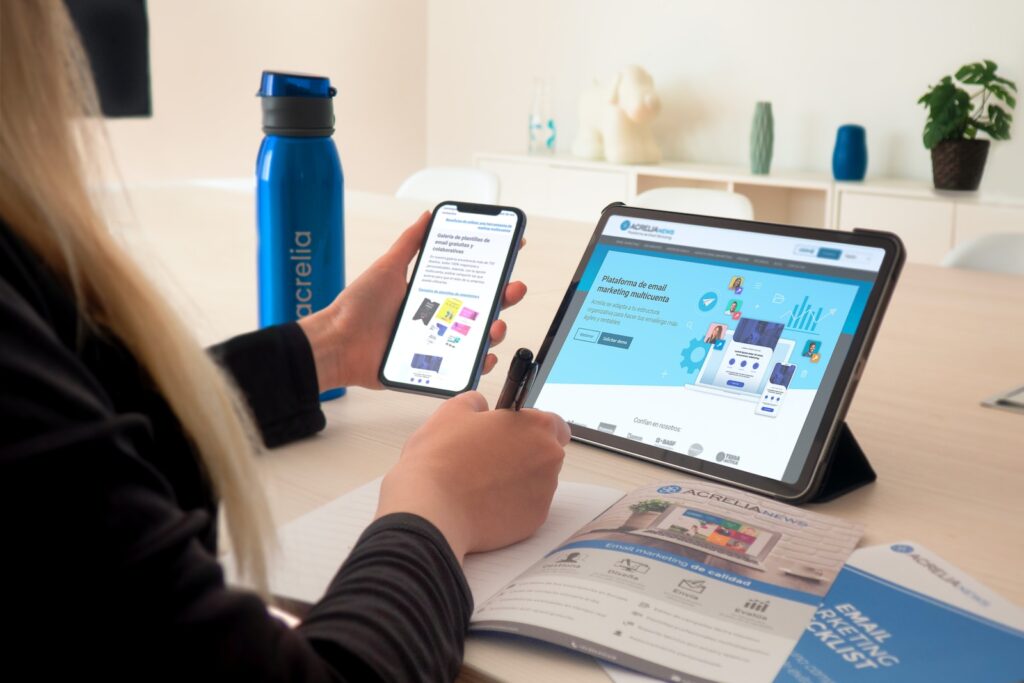Hey there, fellow bloggers! Are you struggling to get your content in front of the right audience? Do you find yourself spending hours on social media and not seeing any significant growth in traffic or engagement? Well, have no fear because email marketing is here!
Picture this: You’re at a crowded party trying to make small talk with everyone in the room. It’s noisy, chaotic, and overwhelming.
Now imagine having the ability to invite only those who are genuinely interested in what you have to say into a quiet corner where you can chat one-on-one without distractions. That’s exactly what email marketing does for your blog – it allows you to connect with your target audience directly and build meaningful relationships that lead to increased traffic, sales, and loyal followers.
So let’s dive into an Introduction to Email Marketing for Blogging!
Understanding The Benefits Of Email Marketing For Bloggers

As a blogger, you’re always looking for ways to grow your audience and increase engagement. That’s where email marketing campaigns comes in.
By targeting your audience directly through their inbox, you can build stronger relationships with your readers and measure the success of your campaigns.
One of the biggest benefits of email marketing is being able to target specific segments of your audience. Maybe you have subscribers who are interested in travel content but not so much in fashion posts. With email segmentation, you can send targeted emails that cater to each group’s interests, increasing the chances they’ll engage with your content.
Measuring the success of your email campaigns is also crucial. With analytics tools at your disposal, you can track open rates, click-through rates, conversions, and more. This data allows you to see what’s working well and make adjustments accordingly to improve future campaigns.
Building Your Email List

Now that you have a better understanding of the benefits of email marketing for bloggers, it’s time to start building your email list.
This is an essential step towards growing your audience and increasing engagement with your content. By collecting contact information from readers who are interested in what you have to offer, you can nurture relationships with them over time.
Creating incentives is one way to encourage people to sign up for your email list. You could offer exclusive content, such as ebooks or webinars, that are only available to subscribers. Or, you might provide early access to new blog posts or discount codes for products and services related to your niche. Whatever incentive you choose should be valuable enough to persuade readers to give you their contact information.
Another important aspect of building your email list is optimizing sign-up forms on your website. Make sure they are easy to find and use on both desktop and mobile devices. Only ask for essential information like name and email address – too many form fields can deter potential subscribers.
Additionally, consider using pop-ups or exit-intent overlays on your site to capture visitors’ attention before they leave.
By taking these steps, you’ll be well on your way toward creating a successful email marketing campaign for your blog. Remember that growing an engaged subscriber base takes time and effort, but the rewards are worth it in terms of increased traffic, improved SEO rankings, and ultimately higher revenue opportunities.
Keep experimenting with different strategies until you find what works best for you!
Crafting Effective Email Campaigns

Did you know that emails with personalized subject lines are 26% more likely to be opened? This statistic highlights the importance of enhancing your subject lines when crafting effective email campaigns.
Your subject line is the first thing subscribers see in their inbox, so it’s crucial to make a lasting impression. But how do you enhance your subject lines? One way is by segmenting your subscribers based on their interests and behaviors.
By sending targeted content to specific groups, you can increase engagement and ultimately drive conversions. For example, if you have a blog about cooking and one subscriber consistently clicks on recipes for vegan dishes, you can send them an email specifically tailored to vegan recipes instead of general cooking updates.
Segmentation not only enhances your subject lines but also allows for greater personalization throughout your entire email campaign. You can address each subscriber by name and tailor the content to fit their individual needs and preferences.
This level of personalization creates a stronger connection with your audience and increases brand loyalty. Incorporating these strategies into your email marketing efforts can lead to higher open rates, click-through rates, and ultimately, conversions.
By enhancing your subject lines through segmentation and personalization, you’ll capture the attention of your readers while providing valuable content that resonates with them personally. Keep experimenting with different techniques until you find what works best for both you and your subscribers!
Personalizing Your Emails For Better Engagement

Now that you’ve got the basics of email marketing down, it’s time to take your strategy up a notch. Personalizing your emails can make all the difference when it comes to engagement and ultimately converting readers into customers.
One way to do this is by creating templates for different segments of subscribers. Rather than sending the same generic message out to everyone on your list, tailor your content based on their interests or behavior.
For example, if someone has previously purchased a product from you, send them an email with related products they may be interested in. Or if someone signed up for a specific opt-in incentive, follow up with content relevant to that topic.
Segmenting subscribers is another crucial step in personalizing your emails. By dividing your list into groups based on demographics, location, or even past purchases, you can create targeted campaigns that speak directly to each group’s needs and preferences.
This not only increases engagement but also shows your subscribers that you value their individuality. So next time you’re crafting an email campaign, think about how you can make it more personalized for your subscribers.
Creating templates and segmenting your list are just two ways to get started – experiment with different strategies until you find what works best for you!
Analyzing Your Email Marketing for Blogging Results

Are you ready to take your email marketing campaigns to the next level? It’s time to analyze your results and see how you can improve your strategies. Measuring success is crucial in any marketing campaign, and email marketing is no different.
Firstly, let’s look at open rates. This metric tells us how many people opened our emails out of all those who received them. A good open rate ranges from 20% to 30%, but it depends on the industry you’re in. If your open rate is below average, try using more engaging subject lines or segmenting your list for better targeting.
Next up is click-through rate (CTR). This measures how many people clicked a link within your email. A high CTR means that your content resonated with your subscribers and encouraged them to take action. To improve this metric, make sure your calls-to-action are clear and prominent, and consider testing different layouts or designs.
Lastly, we have conversion rate. This tracks how many recipients took the desired action after clicking through from your email – whether it be making a purchase or signing up for a newsletter. To boost conversions, ensure that your landing pages match the messaging in your emails and are optimized for mobile devices.
Incorporating these metrics into our analysis allows us to pinpoint areas where we need improvement and adjust our strategies accordingly. Keep track of these numbers over time and continually test new tactics to see what works best for you.
Happy emailing!
Integrating Email Marketing With Your Blogging Strategy

Creating an email list is key to any successful email marketing strategy.
Start by leveraging your blog content to capture readers’ emails and grow your list.
Crafting content is essential to keeping your subscribers engaged – make sure to include relevant stories, tips and offers.
To ensure your emails stand out, get creative with visuals, formatting, and personalization.
Creating An Email List
Are you looking to integrate email marketing into your blogging strategy? One of the most crucial steps in creating an effective email campaign is building a solid email list. But where do you begin?
First, it’s essential to understand the importance of email segmentation. Segmenting your list means dividing it into specific groups based on shared characteristics or behaviors. This allows for targeted and personalized content that resonates with your subscribers. You can segment by demographics, interests, past purchases, and more. By doing this, you’ll increase engagement rates and conversions.
Secondly, lead magnets are a great way to entice people to sign up for your emails. A lead magnet is something valuable that you offer for free in exchange for someone’s contact information. It could be an e-book, webinar, exclusive discount code – anything that aligns with your brand and provides value to potential subscribers. Make sure to highlight the benefits of signing up for your list and how the lead magnet will solve their pain points.
So there you have it! Building an email list doesn’t happen overnight but implementing these strategies will help you attract engaged subscribers who want to hear from you.
Crafting Email Content
Now that you’ve built your email list, it’s time to craft engaging content that will keep your subscribers interested.
One of the first things to consider is crafting compelling subject lines that entice people to open your emails. Keep them short and sweet while addressing a specific pain point or benefit.
Once you have captured their attention with your subject line, focus on creating an effective call-to-action (CTA) strategy. Your CTA should be clear and concise, guiding readers towards taking a specific action such as visiting your blog, making a purchase, or signing up for a webinar. Be sure to use actionable language and place your CTA in strategic places throughout the email.
Remember that crafting email content is an ongoing process – don’t be afraid to experiment with different formats and styles until you find what works best for your audience.
By consistently providing valuable content and using effective CTAs, you’ll continue to build strong relationships with your subscribers and drive conversions over time.
Tips For Successful Email Marketing As A Blogger

Now that you have a basic understanding of email marketing, let’s dive into some tips for success.
The first tip is to focus on creating compelling subject lines. This is the first thing your audience sees and will determine whether they open or delete your email. Make sure it’s catchy, relevant, and personalized to grab their attention.
Another important aspect of successful email marketing is optimizing delivery times. You want to make sure you are sending emails at the right time when your audience is most likely to engage with them. Research shows that weekdays tend to be better than weekends and early morning or late afternoon tends to have higher open rates.
By following these tips, you can increase engagement and conversions through email marketing as a blogger. Remember, always test different strategies and track your results to see what works best for your specific audience.
And above all, keep providing valuable content that keeps your subscribers coming back for more.
Key Takeaways
- Email marketing allows bloggers to connect directly with their target audience and build meaningful relationships.
- Targeted emails through segmentation increase engagement by catering to specific interests.
- Analyzing email campaign metrics such as open rates, click-through rates, and conversions helps improve future campaigns.
- Personalizing emails based on subscribers’ interests and behaviors enhances engagement and brand loyalty.
- Building an email list requires creating incentives and optimizing sign-up forms on websites.
- Crafting effective email campaigns involves enhancing subject lines, segmenting subscribers, and incorporating personalization.
- Analyzing email marketing results involves measuring open rates, click-through rates, and conversion rates.
- Integrating email marketing with blogging strategy involves leveraging blog content, creating email templates, and personalizing emails.
- Tips for successful email marketing include focusing on compelling subject lines, optimizing delivery times, and providing valuable content.
- Frequently asked questions cover email frequency, list segmentation, avoiding spam, using multimedia, and legal requirements.
Useful Table
| Topic | Key Takeaways |
|---|---|
| Email Marketing | – Connect directly with the target audience |
| – Build meaningful relationships | |
| – Measure success with analytics tools | |
| – Segment subscribers for targeted emails | |
| Building Email List | – Create incentives to encourage sign-ups |
| – Optimize sign-up forms on websites | |
| Crafting Email Campaigns | – Enhance subject lines through segmentation |
| – Personalize content for individual subscribers | |
| Analyzing Results | – Measure open rates, click-through rates, and conversions |
| Integrating with Blog | – Leverage blog content to capture emails |
| – Create email templates for different segments | |
| Personalizing Emails | – Tailor content based on subscribers’ interests or behavior |
| – Segment subscribers for targeted campaigns | |
| Tips for Success | – Focus on compelling subject lines |
| – Optimize delivery times | |
| – Provide valuable content |
Frequently Asked Questions
How Often Should I Send Emails To My Subscribers?
You know what they say: absence makes the heart grow fonder. But when it comes to email frequency, that’s not always the case.
While you don’t want to bombard your subscribers with daily emails (unless you’re offering something truly irresistible), you also don’t want them to forget about you entirely.
So, how often should you send emails? Well, it all depends on your subscriber engagement. If they’re opening and clicking through regularly, then keep up the good work!
But if your open rates are plummeting faster than a rollercoaster drop, it’s time to reevaluate your strategy.
Ultimately, finding the perfect balance of email frequency is key for keeping your audience engaged and interested in what you have to offer.
What Is The Best Way To Segment My Email List?
Hey there! Are you wondering what the best way is to segment your email list?
Well, personalization techniques and target audience analysis are key factors in determining how to go about it. By utilizing these methods, you can tailor your content specifically for each group within your subscriber base.
This not only helps increase engagement but also ensures that the right message reaches the right people at the right time. So, take some time to analyze your subscribers’ demographics, interests, and behaviors to determine which segments will benefit most from your content.
Happy emailing!
How Do I Avoid My Emails Being Marked As Spam?
Oh, the joys of email marketing! The thrill of crafting the perfect subject line and body copy only to have your emails sent straight to spam. It’s like throwing a party but no one showing up because they couldn’t find the address.
So how do we avoid this tragedy?
First off, let’s talk about Email Content – make sure it’s relevant and valuable to your audience so they don’t mark you as spam themselves.
Next, focus on Email Deliverability by ensuring your sender reputation is in good standing with internet service providers.
Keep these tips in mind and you’ll be hosting the best email parties around town (minus the spam).
Can I Use Images And Videos In My Email Campaigns?
Using multimedia in emails can be a great way to engage with your audience and make your content more visually appealing. Including images and videos in your email campaigns is proven to increase click-through rates and overall engagement levels.
However, it’s important to measure the effectiveness of these elements by analyzing metrics such as open rates and time spent on the email. By doing so, you can fine-tune your approach and ensure that your multimedia content is truly resonating with your subscribers.
So don’t be afraid to get creative with visuals in your next email campaign – just remember to keep track of how they’re performing!
Are There Any Legal Requirements I Need To Follow When Sending Emails To Subscribers?
Hey there! When it comes to sending emails to your subscribers, there are a few legal requirements you need to follow in order to stay compliant with the law.
First off, you’ll want to make sure that all of your subscribers have opted-in to receiving communications from you. This is known as opt-in requirements and means that they’ve given explicit permission for you to contact them.
Additionally, you’ll want to ensure that any emails you send out include an easy way for recipients to unsubscribe if they no longer wish to receive messages from you.
Finally, it’s important to be aware of CAN SPAM compliance regulations which govern how commercial email messages can be sent and require things like accurate header information and clear identification of advertisements.
By following these guidelines, you can help maintain a positive relationship with your subscribers while also staying on the right side of the law.
Final Thoughts
In conclusion, email marketing is an essential tool for bloggers to connect with their subscribers and keep them engaged.
By sending regular emails, your audience can stay up-to-date on the latest content you publish and special promotions or events that you may offer.
As a blogger, it’s important to segment your email list so that you can send targeted messages that are relevant to each subscriber. This will help increase engagement rates and reduce the likelihood of your emails being marked as spam.
So, whether you’re just starting out or looking to improve your current email marketing strategy, remember to follow legal requirements, use engaging visuals, and always provide valuable content in every message you send.
With these tips in mind, your email campaigns are sure to resonate with your audience and drive more traffic back to your blog!

